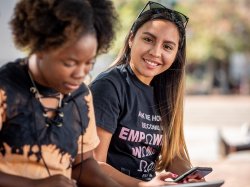Montclair State’s student body reflects, in every way, the diversity of New Jersey and the society it serves. Coming from virtually every demographic and socioeconomic group, from big cities and small towns, students arrive on a campus where everyone feels included and welcomed.
The University has cultivated an intentional effort to enhance its inclusivity over nearly five decades under a series of presidents. It began in 1973 with President David W.D. Dickson – the first African American appointed to head a four-year New Jersey higher education institution. Twenty-one years later, Irvin Dexter Reid, the University’s second African American president, led efforts to elevate Montclair State from a college to a university. Its first female president, Susan A. Cole, appointed in 1998, committed the University to reflect the diverse population of New Jersey and created the President’s Commission on Affirmative Action, Equal Opportunity and Diversity.
The evolution includes building stronger bridges to surrounding communities and creating partnerships with local schools, governments, businesses and nonprofit organizations to address the challenges of cities like Newark, Orange and Paterson. Faculty and students are engaged in coursework and research projects that address a range of urban concerns, including clean water, criminal justice reform, public health, sustainability and equity in K-12 education. In addition, performances in the College of the Arts are open to the public and outreach programs connect the University and communities through dance, theater and music.

The University has experienced considerable success in recruiting, retaining and graduating students of color. The U.S. Education Trust honored Montclair State as a “Top Gap Closer” for increasing graduation rates for minority students, and several national rankings, including U.S. News & World Report, Forbes and Washington Monthly, have recognized the University as one of the top schools for social and economic mobility.
Another bright spot has been significant growth in Hispanic student enrollment. Montclair State now enrolls more Latinx undergraduates than any other New Jersey higher education institution, has been recognized as one of the Top 100 Colleges for Hispanics each year for the past 18 years by Hispanic Outlook on Education magazine, and has been officially designated by the U.S. Department of Education as a Hispanic-Serving Institution. This recognition emphasizes the University’s commitment to Latinx students and their families in increasing access to college, and achieving academic and career success. A recent $2 million National Science Foundation grant will create new experiential learning opportunities in STEM fields for Hispanic students.

Montclair State serves many lower-income and first-generation students. The highly successful Educational Opportunity Fund (EOF) program, which recently marked its 50th anniversary, is a national model for creating access and opportunity for highly motivated students from disadvantaged backgrounds, who are provided support and guidance to reach their educational goals.
The University has been consistently named one of the most LGBTQ+ friendly campuses by respected organizations such as College Consensus and Campus Pride Index, in recognition of its commitment to making the campus safe and an ideal learning environment for all students through programs like Safe Space, which trains staff, faculty and student leaders, and the LGBTQ Center, which provides education and cultural opportunities.
Montclair State’s demographic shift also includes a steady increase in student qualifications. The grade point average of admitted freshmen (currently 3.27) continues to move upward, as does the rigor in their high school curricula. The Presidential Scholars Program attracts diverse and talented in-state students to campus, while the National Student Scholarship draws high-achieving, out-of-state students by providing them with in-state tuition rates.
